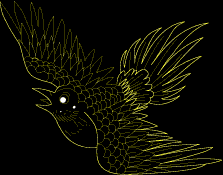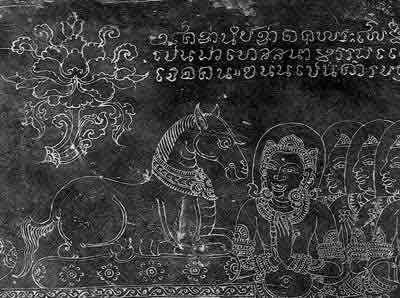 Thai mural painting is unique to the
visual arts because of conventions
that are entirely its own. This style
of painting creates scenes without
shading or shadows and generally
ignores perspective. It pays no
particular attention to anatomy,
although the use of a refined and
highly stylized line makes shapes
of figures idealistic. Mural artists
pay little attention to observational
style drawing. Thai mural painting is
likely to use color to denote space,
scale to denote importance, and
zigzag lines for a change of place.
But it may have the same character
repeated several times in the same
space even if that character is at
a different time within the same
story.
Much of the content inside these works is
from the Ramakien, which are Traditional Thai
stories of the Buddha's ten past-lives before
reaching Enlightenment. The treatment of the
subject matter is delicate and supportive. It
has landscapes with dramatic mountain scapes
and mythological beasts. But it is not without
a sense of humor. It is common to have scenes
of teenagers fighting, street vendors selling
or even lovemaking mixed in with these ancient
stories. At times there are historical
analogies comparing Thailand's enemies to the
armies of Mara dispatched to stop the Buddha
from reaching enlightenment.
|
Traditionally, these works are painted on the inside walls of temples. Many ancient murals have been lost because their nature is temporary. Contemporary artists who have proven their skill are sometimes asked to restore historical and/or respected murals. Works like these have never received recognition in the English art history texts, but have been a vital part of an Eastern art form for at least 600 years.
*As more people come to realize that this is an ancient artistic heritage, this important style would be able to be taught in the West.
 In contemporary western art it would indeed be rare to see the human form depicted with both the gracefulness of Velazquez and the pathos of the ancient Greeks with a highly stylized line and a pervasive, negative space. As western art has pushed itself away from mythology and even the human form, Thai mural painting continues its tradition of respect for beauty and mysticism.
In contemporary western art it would indeed be rare to see the human form depicted with both the gracefulness of Velazquez and the pathos of the ancient Greeks with a highly stylized line and a pervasive, negative space. As western art has pushed itself away from mythology and even the human form, Thai mural painting continues its tradition of respect for beauty and mysticism.
- Sam Forkner
*This drawing on slate is from the Sukhothai period from an unknown artist. It is not only a masterfully executed work, it suggests a tradition of art that is much older than the work itself.

This picture of this Sukhothai period slate has been taken from the Bangkok Bank's Publication of the "Bua Luang Artits Awards"
|
Content supervisor & writer: Pakorn Prohmvitak
Site design & writer: Sam Forkner
All rights reserved. None of the content on Thai Art Magazine may be reproduced with out express consent. Copyright © 2005, 2011 Bangkok, Thailand.

 In contemporary western art it would indeed be rare to see the human form depicted with both the gracefulness of Velazquez and the pathos of the ancient Greeks with a highly stylized line and a pervasive, negative space. As western art has pushed itself away from mythology and even the human form, Thai mural painting continues its tradition of respect for beauty and mysticism.
In contemporary western art it would indeed be rare to see the human form depicted with both the gracefulness of Velazquez and the pathos of the ancient Greeks with a highly stylized line and a pervasive, negative space. As western art has pushed itself away from mythology and even the human form, Thai mural painting continues its tradition of respect for beauty and mysticism.
